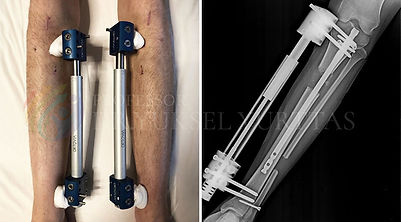LON Method
Cost-Effective Limb Lengthening with Proven Results
The LON (Lengthening Over Nails) method is a widely used and cost-effective approach for limb lengthening. By combining intramedullary nails with external fixators, this technique provides an ideal balance of affordability, comfort, and effectiveness. This method allows patients to safely increase their leg length in a relatively short period while minimizing risks and discomfort with proper care.
How Does the LON Method Work?
The LON method involves placing an internal nail inside the bone, which remains connected to an external fixator during the distraction phase (lengthening process). Once the desired length is achieved, the external fixator is removed through a minor surgical procedure, while the internal nails continue to support the bone until full consolidation. The LON method is weight-bearing, enabling patients to begin walking with assistance as early as 2-3 weeks after surgery. This early mobility helps patients maintain independence and meet their daily needs throughout the lengthening phase.
How Much Taller Can You Get with the LON Method?
Typically, patients can gain up to 10 cm (4 inches) in the femur in about 3 months and 7 cm (2.75 inches) in the tibia within 2-2.5 months with one procedure. For patients aiming for more height, a two-step process can provide up to 17 cm (6.7 inches) of gain with a 5-6 month treatment plan.
The lengthening process starts three days after surgery, with adjustments made four times daily, with each adjustment lengthening the bone by 0.25 mm, resulting in a total of 1 mm per day. The lengthening rate can sometimes be increased based on medical assessment. The exact amount varies depending on factors such as muscle flexibility, bone health, and adherence to post-operative care. If your goal is to achieve the maximum height safely, you will need to focus on regular physiotherapy and consistent exercise throughout the lengthening process.

This image shows the femur lengthening procedure using the LON method. Patients can achieve up to 10 cm (4 inches) of height increase in one procedure with this technique. It is a popular choice for patients looking for maximum height gain in a single treatment.

The LON method for tibia lengthening is shown here. Patients can gain up to 7 cm (2.75 inches) in height with this approach. This option is often chosen by those looking to correct leg deformities, balance leg length discrepancies, or enhance overall limb symmetry while increasing their height.
Advantages of the LON Method
-
Height Gain Potential: Achieve up to 10 cm (4 inches) in the femur and 7 cm (2.75 inches) in the tibia with the LON method, making it ideal for those seeking significant height increase safely.
-
Shorter Time with External Fixators: External fixators are needed only during the lengthening phase, reducing the discomfort associated with traditional limb lengthening methods like the Ilizarov technique.
-
Fully Weight-Bearing During Lengthening: Patients can begin walking with assistance during the lengthening phase, promoting better blood circulation and faster adaptation.
-
Promotes Faster Healing: Walking during the lengthening phase encourages blood flow, which aids in quicker bone regeneration and overall recovery.
-
Faster Return to Daily Life: Most patients can walk independently and gradually return to their daily activities within 4-5 months after surgery, making the recovery process smoother and more manageable.
-
Minimized Scarring: Results in fewer scars compared to methods that use circular fixators for limb lengthening.
-
Affordable Limb Lengthening: Provides a cost-effective and safe option for those seeking height improvement without compromising quality.
Disadvantages of the Method
-
Pin Site Care: Requires daily cleaning and dressing to prevent infections and maintain pin site hygiene.
-
Visible Scarring: More scarring compared to fully internal lengthening methods, such as the Precice 2.
-
Discomfort Due to External Fixators: Patients may experience some discomfort from the external fixators during the lengthening phase.
Watch First-Hand LON Patient Experiences
Recovery Timeline for the LON Method
-
Day 1: Arrival in Istanbul and rest.
-
Day 2: Doctor consultation, examination, and preoperative tests.
-
Day 3: Surgery (lasting 2-3 hours).
-
Day 4: Post-surgery care in the hospital.
-
Day 5: First steps after surgery.
-
Day 6-7: Rehabilitation with bed exercises and short walks.
-
Day 8: First lengthening begins.
-
Day 9-10: Discharge from the hospital. Start of physiotherapy and exercise program.
-
Day 60-90: Distraction phase, which involves daily lengthening adjustments, intensive physiotherapy, and rehabilitation.
-
Day 60-90: External fixator removal.
-
Day 70-150: Bone consolidation and transition to normal walking.
-
Day 150-365: Complete bone consolidation and full recovery.
Is the LON Method Right for You?
The LON method is an effective and affordable limb lengthening option. It allows for mobility during the lengthening phase and offers a relatively fast recovery. However, success requires dedication to post-operative care, including physiotherapy and maintaining pin site hygiene. If you are prepared for the commitment, the LON method may be the right solution for your needs.


